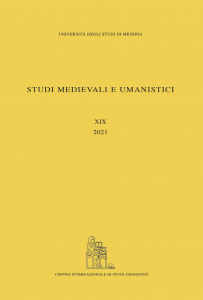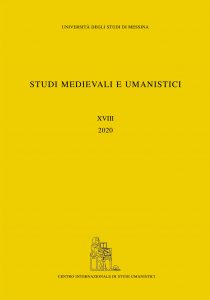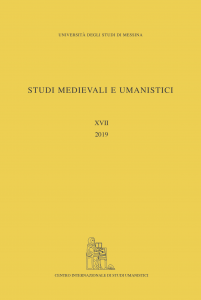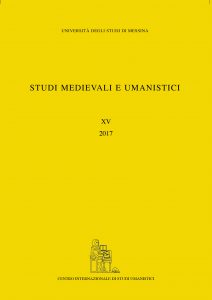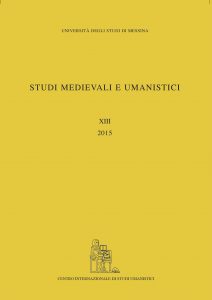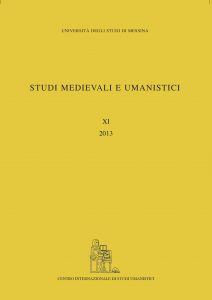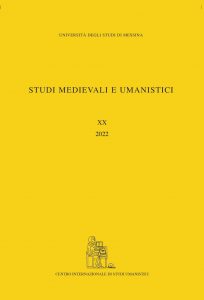
XX (2022)
Messina, Centro Internazionale di Studi Umanistici, 2022, 286 pp., tavv. VIII; 25 cm.
ISSN 2035-3774
€ 80
SOMMARIO
Vincenzo Fera, Nodi ecdotici petrarcheschi: il caso di prestringere/perstringere
Silvia Fiaschi, Un ritrovato codice aragonese di Silvestro Galeota per il duca Pierre II de Bourbon: cronaca di una scoperta
Luigi Orlandi, Sull’epigramma greco-latino in morte di Bessarione
Paola de Capua, Filippo Beroaldo e la descrizione della villa di Pontecchio di Mino de’ Rossi
Paola Megna, Dalla versione omerica alla filologia dei Miscellanea: Poliziano vs Merula
Giovanni Cascio, Intarsi lucanei. Il pianto di Cesare nell’Itinerarium petrarchesco
TESSERE
S. Rocchi, Accursiana IV. Carmi latini epigrafici angioini all’Aquila (Fontana della Rivera e Porta Barete)
G. Cascio, ‘Itinerari’ fantasma fra Petrarca e Boccaccio
S. Pagliaroli, Una notizia di Mario Correggi su Leonello II Pio di Carpi
P. Megna, Poliziano, Cicerone e la profezia di Calcante (Il. 2, 299-330)
P. Megna, Per la fortuna umanistica degli Pneumatica di Erone Alessandrino
Indice delle tavole
Indice dei manoscritti e delle fonti d’archivio
Indice dei nomi
ABSTRACT
VINCENZO FERA, Nodi ecdotici petrarcheschi: il caso di pre-stringere/perstringere
The article maps the presence of the verbs ‘prestringere’ and ‘perstringere’ in Petrarch’s work, which were rarely used in fourteenth-century Latin literature. The findings of the research are significant for the constitutio of Petrarchan texts.
SILVIA FIASCHI, Un ritrovato codice aragonese di Silvestro Galeota per il duca Pierre II de Bourbon: cronaca di una scoperta
This essay illustrates the relevant discovery of a hitherto unknown Aragonese manuscript, commissioned by Ferrante of Aragon for the Duke Pierre II de Bourbon in 1481, found in Fermo at the Biblioteca del Seminario Arcivescovile ‘F. De Angelis’. The paper provides a detailed description of its material aspects, with particular regard to the sumptuous binding, an authentic masterpiece and a unicum in the sphere of the surviving Aragonese bindings. It reconstructs the historical and cultural context of reference for its production, and analyses its contents, which transmit a hitherto unknown consilium de podagra by the royal archiater Silvestro Galeota, a prestigious figure at Ferrante’s court, but of whom no literary evidence has been known so far.
LUIGI ORLANDI, Sull’epigramma greco-latino in morte di Bessarione
The article aims at solving important issues surrounding the poem dedicated to Cardinal Bessarion on his death. Although it is well-known, a few aspects concerning the text and its transmission are yet unclear, the main one being its authorship. With the help of some clues arising from the study of the manuscript transmission, it is possible to get to the solution. A critical edition of the Greek and Latin versions of the poem, an Italian translation, and explanatory notes are also provided.
PAOLA DE CAPUA, Filippo Beroaldo e la descrizione della villa di Pontecchio di Mino de’ Rossi
The essay re-reads the well-known description of Mino de’ Rossi’s Ponticulan villa within Filippo Beroaldo’s commentary on Apuleius. By focusing on cultural, political and social themes, intertwined with the research itineraries of the Bolognese humanist, the A. highlights a new and original outcome in the traditional rhetorical device of ecphrasis.
PAOLA MEGNA, Dalla versione omerica alla filologia dei Miscellanea: Poliziano vs Merula
The essay reviews various remarks about Homeric criticism in Poliziano’s writings, focusing on chapter 40 of the second Miscellanea, which deals with the exegesis of quadrupes in Ter. Andria 865. Starting from a passage of Heliodore/Oribase’s De ligaturis, Poliziano addresses the problem of technical and scientific vocabulary, including Homeric lexicon, in the Aristotelian translations by Theodore Gaza: the chapter is an interesting, hitherto neglected, episode of his polemic with Giorgio Merula.
GIOVANNI CASCIO, Intarsi lucanei. Il pianto di Cesare nell’Itinerarium petrarchesco
The article proposes a new interpretation of a particularly cryptic passage of the Itinerarium by Francesco Petrarca. The author demonstrates how the episode in which Caesar is depicted in tears at the sight of Pompey’s severed head, while the Fortuna populi romani mourns the headless torso of the Roman leader, can be explained as a mosaic of tiles taken from several books of Lucan’s Bellum civile. Furthermore, the ascertainment of the peculiar ideological function of the iunctura ‘Fortuna populi romani’ contributes to a better understanding of the passage.
STEFANO ROCCHI, Accursiana IV. Carmi latini epigrafici angioini all’Aquila (Fontana della Rivera e Porta Barete)
This paper provides a critical edition of three medieval carmina latina epigraphica
from L’Aquila (Abruzzo), carefully copied by Mariangelo Accursio within his epigraphical
notes as important documents of the early urban development of the town.
The A. also shows how the humanist made use of these inscriptions to prove
Biondo’s and Pontano’s theories wrong about the origin of L’Aquila.
GIOVANNI CASCIO, ‘Itinerari’ fantasma fra Petrarca e Boccaccio
The article deals with two little-known episodes regarding the reception of Petrarch’s
‘Itinerarium’ in the 16th-17th centuries. Some peculiarities of the manu –
script tradition led to two mistakes, by attributing to Giovanni Boccaccio an
imaginative Itinerary to the Sepulchre of Petrarch, and by making Petrarch himself
the author of a second ‘Itinerary’.
STEFANO PAGLIAROLI, Una notizia di Mario Correggi su Leonello II Pio di Carpi
An annotation in the manuscript Vat. Ott. lat. 1966, written by Mario Correggi from
Mirandola, enables the A. to establish the death date of Leonello II Pio, father of
Alberto III, Aldus Manutius’s pupil in Carpi.
PAOLA MEGNA, Dalla versione omerica alla filologia dei Miscellanea: Poliziano vs Merula
In his youthful version of the Iliad, Poliziano borrows Cicero’s translation (De div.
2, 63-64) of Il. 2, 299-300, i. e. Ulysses’ account of Calchas’ prophecy, which Cicero
mistakenly attributed to Agamennon: the essay reconstructs the humanist’s extensive
study on this passage, which he collated and corrected in his incunabulum of Cicero’s
writings, and also used in chapter 53 of the first Miscellanea, devoted to Cicero’s
errata memoriae.
PAOLA MEGNA, Per la fortuna umanistica degli Pneumatica di Erone Alessandrino
The essay examines some aspects of the manuscript tradition of Hero of Alexandria’s
Pneumatica in the 15th century; the analysis of the quotations from this work
in chapter 97 of the first Miscellanea and in the Panepistemon shows that Poliziano
probably had access to a manuscript of the Pnemautica that is now lost.
